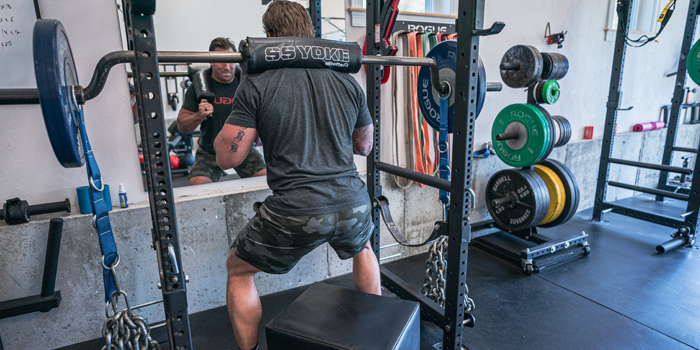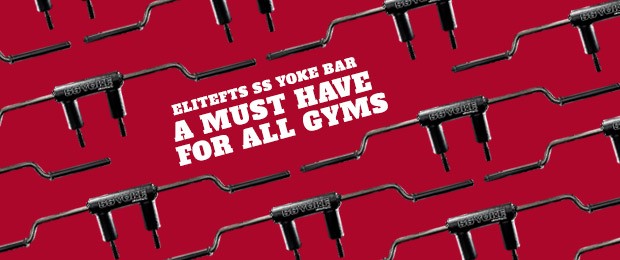
The Safety Squat Yoke Bar (SSB) has become a household name at just about any facility and even in the garage gym scene. Many of the popular equipment review sites like Garagegymreviews.com have reviewed a long list of SSBs, but the SSB always prevails. With that said, it's no mystery that this bar is great for squatting and has a number of benefits vs. a straight bar that you can read about in-depth on this site. What's interesting about this bar is it can be used for more than just squatting. We use the SSB for squatting regularly, but more so in the front rack position.
Here's the list of our top variations:
SSB Front Box Squat
As previously stated, using the SSB in the front rack position presents a new variation but also removes some of the spinal compression if you're already suffering from lower-back issues. It's a great alternative that will allow you to squat pain-free. Additionally, because of the pad, this front rack position is much more user-friendly than a straight barbell. You'll find your ability to brace is even greater too.
We use the variation in almost all schemes such as max effort work, dynamic effort work, and submaximal effort work.
Tall Kneeling SSB Press Off of Pins
This is a variation that is much harder than it appears. Reason being, the hand position is going to challenge the triceps to a larger degree, keeping constant tension through the range of motion. And performed from a tall-kneeling position forces the athlete to engage the anterior core and NOT over-extend to create an artificial range of motion, which could put undue stress on their lumbar spine. Moreover, pressing from pins breaks up the phases of the lift, allowing you to use less overall load to achieve great cumulative training effects. In this case, we'll use this variation in a repetitive effort scheme as a secondary lift on a max effort or dynamic effort upper training day.
SSB Front Rack Rear Foot Elevated Split Squat
This is an absolutely brutal variation that is NOT a good choice for newer athletes, but for more experienced trainees looking to challenge their single-leg variation. The demand both on the posterior and anterior chain is high, and the balance requisite tends to be more significant than the standard dumbbells held by your side. The advantage here though, is the ability to create tension with an anterior load. We've used this in a variety of scenarios for repetition effort work as well as dynamic effort work (believe it or not this variation works quite well done with maximal intent and lighter loads.)
SSB JM Press with Chains
This one won't come as a shock as I know many of you include this one in your triceps work routinely, but it's tough to write a list of SSB variations and NOT include the SSB JM Press. In this case, we've gone as far as including heavy chains (the chain weight exceeds the straight weight.) This setup provides an altered strength curve, so you're receiving all of the benefits with less overall stress to the elbow joints. You'll want to use this one as a secondary lift on ME or DE Upper performing sets of 6-10 reps.
SSB Goodmorning with Reverse Bands
I'm not a huge fan of good mornings for general fitness as the gravity line created with this range of motion brings the load further away from the center of mass, thus putting a fair amount of stress on the lumbar spine. When adding reverse bands to the mix, most can dial in better motor patterns and improve their hip-hinge patterning. We use reverse bands almost exclusively to improve motor patterns as opposed to how many folks use them to reach supramaximal loading. Affixing a doubled mini-band or micro-band at the top of your rack will work quite well in terms of receiving the training effects of this posterior-chain work without the risk of any compensatory movement.
SSB Front Rack Walking Lunges
Our final variation was a toss-up between the SSB Back Raise OR the SSB Walking Lunge. I've opted for the lunge variation for a few reasons. First, most people that are training for general fitness love a good lunge variation because of the psychological effects of "feeling the burn," but using the SSB adds an additional component and demand on the abdominals. The one caveat though, is that getting the bar into place from the ground can be tough if you're using a considerable load. With that said, we tend to use these for more strength-endurance based work with sets of 20-40 reps (typically 75-100 total reps completed). You'll also want to perform these last in your training session as you won't be able to do much thereafter.
Closing
The SSB is quite possibly the best bar known to man. This article isn't meant to sell you the SSB, but we've had so much success with this bar; it's hard not to share our experiences with it. Personally, if I'm squatting, regardless of the variation, it's with the SSB as squatting with a straight bar doesn't serve any of my goals at this point in my life. And if you're looking to optimize how you use your SSB, think outside the box. As Louie says, "You're only limited by your imagination."











--that said, the fact that you didn't include the SSB BOX SQUAT is INSANE!!
The word "new" in the title is why I did not - imagine how many people would say "SSB Box Squats are far from NEW!" Lol!